In which Sid and Doris cross the Danube and from Hungary to Serbia and have their passports stamped.
Today we crossed into a part of Serbia that once had a large German population, probably over 5000,000. Some of the road signs in Hungary and Serbia still use the German town names. There are a few Germans left. The Republic of Serbia has a commission to investigate the crimes committed between 1944 and 1948 by Yugulavs against the German population (which had no part in the fighting) at around 100 murder camps in the region. No one has ever been prosecuted. An elderly German woman who was asked to talk about what happened said she could not, she might lose her pension. And before she had never said anything in case she might lose her salary. Germany has come to terms with itself better than Serbia. One reason no one wants to say anything is that families that benefited from the confiscation of German farms and homes might still fear restitution. See ‘The Sixty Year Silence.’
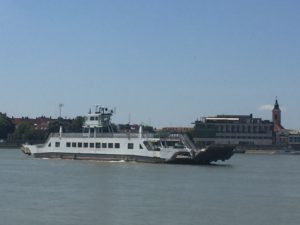 Anyway, Sid and Doris bashed on, initially along the dyke roads making another 92 kilometres going South, loosely in touch with the Danube. Our first stop was at the Mohacs ferry cafe. The Danube still has quite a lot of small ferries and, says Sid, stands to reason we will find a cafe in this otherwise empty quarter.
Anyway, Sid and Doris bashed on, initially along the dyke roads making another 92 kilometres going South, loosely in touch with the Danube. Our first stop was at the Mohacs ferry cafe. The Danube still has quite a lot of small ferries and, says Sid, stands to reason we will find a cafe in this otherwise empty quarter.
In Mohacs there are monuments to battles with the Turks, in 1526. Long enough ago that no one has much skin in the game.
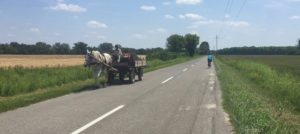
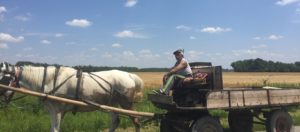 The road is long. It is not winding. We see a horse and cart. The game of Eye Spy is soon over. The wind is in our faces. It is very hot. But, good news: road surface pretty decent and traffic light.
The road is long. It is not winding. We see a horse and cart. The game of Eye Spy is soon over. The wind is in our faces. It is very hot. But, good news: road surface pretty decent and traffic light.
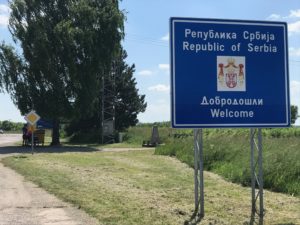
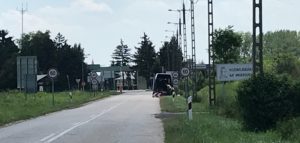 Real excitement comes with a proper border crossing from Hungary to Serbia. There is an Out control and an In control where we have our passports properly examined and carefully Stamped.
Real excitement comes with a proper border crossing from Hungary to Serbia. There is an Out control and an In control where we have our passports properly examined and carefully Stamped.
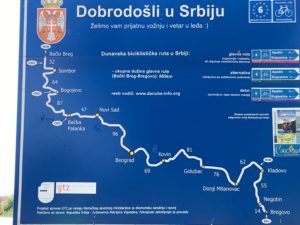 There is also a map of the route to come, which bodes well for careful surface-selection and way marking by the route setters (we can but hope).
There is also a map of the route to come, which bodes well for careful surface-selection and way marking by the route setters (we can but hope).
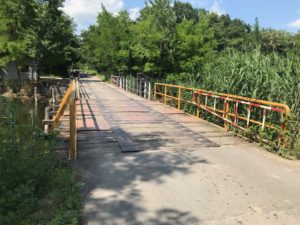 Later we cross the sort of bridge Gerard Brown would pick for an ERA photo, though the mosquitos soon chased us away.
Later we cross the sort of bridge Gerard Brown would pick for an ERA photo, though the mosquitos soon chased us away.
So on this dull transit day Sid passed the time interviewing “S”, our coach and scientificable advisor on EECC. Extreme Energy Conservation Cycling is a special way of making progress.
Sid: So, “S”, tell us about gear selection.
“S”: Be in a gear when when you can spin along. Speed is not really important so long as you can see your way into the hotel before 6PM.
Sid: So, “S”, how should we deal with lactic build up in the muscles?
“S”: You should never put any business in your legs. This is not about training. It is about being able to cycle again tomorrow.
Sid: How can we reduce effort?
“S”: Even the smallest peloton will help. The total effort expended by two will be reduced by about 15% if you take it in turns to draft. Even the one on the front gets a benefit from reduced drag. It is more important at cruising speeds than when going uphill or on farm tracks because drag rises as the square of the speed. So draft each other all the time you have the patience for it. Drafting other people is even better.
Sid: In an EECC world how should we think about day length?
“S”: Different surfaces and slopes will imply different speeds. In an EECC system it is the speed that changes, not the effort, which is kept low. The energy required for 22kph on a good road, will translate into 16kph uphill and as little as 8kph on a really wretched farm track. Time is measured in bottom and upper spine tolerance. So no day must involve more than 6 moving hours. So a day may give 120 kilometres or 48. Head winds can knock these back. No cyclist has ever reported a tailwind.
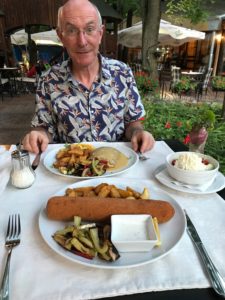 And so Sid, Doris and “S” come into Sombor, once a German centre. But then also Turkish and Austrian. They all brew beer, so Dva piva, molim vas. We ordered the local specialities “so, Sir, are you sure your wife wants to eat pastry-wrapped horse’s pizzle?”
And so Sid, Doris and “S” come into Sombor, once a German centre. But then also Turkish and Austrian. They all brew beer, so Dva piva, molim vas. We ordered the local specialities “so, Sir, are you sure your wife wants to eat pastry-wrapped horse’s pizzle?”